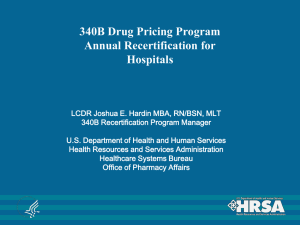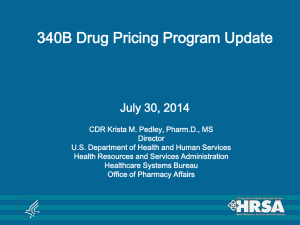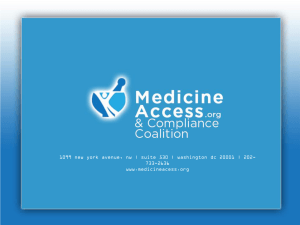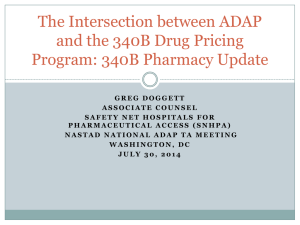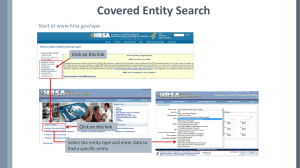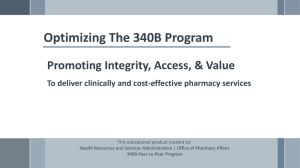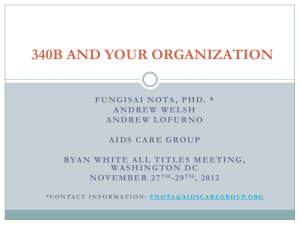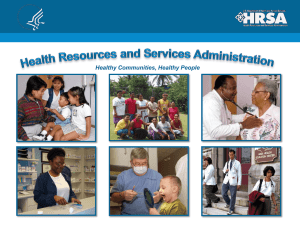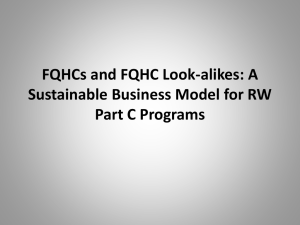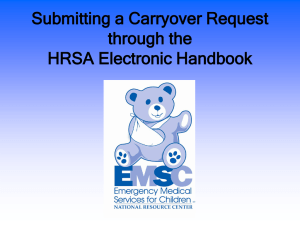Presentation 1 - TARGET Center
advertisement
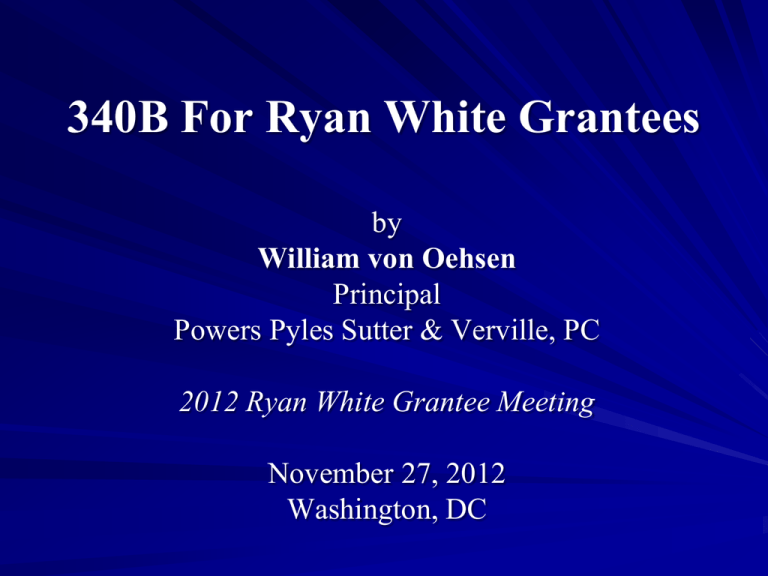
340B For Ryan White Grantees by William von Oehsen Principal Powers Pyles Sutter & Verville, PC 2012 Ryan White Grantee Meeting November 27, 2012 Washington, DC Overview I. 340B Primer - Background - Covered entities - Calculating ceiling price - Covered entity restrictions - Contract pharmacies III. 340B Reform Legislation - Medicaid changes - Integrity provisions - Recertification IV. Audits II. Covered Entity Restrictions - Duplicate discounts - Anti-diversion Powers Pyles Sutter & Verville, PC (202) 466-6550 Bill von Oehsen william.vonoehsen@ppsv.com 340B Primer: Background 340B drug discount program requires pharmaceutical manufacturers participating in the Medicaid program to provide discounts on covered outpatient drugs purchased by federally-funded clinics and other safety net providers referred to as “covered entities” (CEs) The rights and obligations of CEs and manufacturers are set forth in Section 340B of the Public Health Service Act (PHSA) Section 1927 of the Social Security Act (SSA) requires manufacturers to enter into a pharmaceutical pricing agreement (PPA) with the Secretary of HHS as a condition of Medicaid and Medicare Part B covering the companies’ outpatient drugs Under the PPA, a manufacturer agrees to provide discounts and otherwise comply with 340B requirements Powers Pyles Sutter & Verville, PC (202) 466-6550 Bill von Oehsen william.vonoehsen@ppsv.com 340B Primer: Background (cont’d) Program is administered by the Health Resources and Services Administration (HRSA) through the Office of Pharmacy Affairs (OPA) Because several aspects of the 340B program depend on interpretation and application of SSA provisions (e.g. average manufacturer price, best price, etc.), the Centers for Medicare & Medicaid Services (CMS) also plays a significant role in 340B program administration Two HRSA contractors: Prime Vendor Program (PVP) and Pharmacy Support Services Center (PSSC) Powers Pyles Sutter & Verville, PC (202) 466-6550 Bill von Oehsen william.vonoehsen@ppsv.com 340B Primer: Covered Entities Originally 12 categories of CEs: – high-Medicaid disproportionate share (DSH) hospitals owned by or under contract with state or local government – community health centers – ADAPs – AIDS, TB and STD clinics – family planning clinics – and other PHSA grantees The non-hospital CEs are only permitted to purchase and use 340B-discounted drugs within the scope of their 340B-qualifying federal grants Powers Pyles Sutter & Verville, PC (202) 466-6550 Bill von Oehsen william.vonoehsen@ppsv.com 340B Primer: Covered Entities (cont’d) Patient Protection and Affordable Care Act (PPACA) added five new categories of hospitals eligible for 340B: – Free-standing children’s hospitals with DSH adjustment > 11.75% – Free-standing cancer hospitals with DSH adjustment > 11.75% – Critical access hospitals – Sole community hospitals and rural referral centers with DSH adjustment ≥ 8% All 340B hospitals must either be publicly owned or be a private nonprofit contracting with a state or local government to provide indigent care Powers Pyles Sutter & Verville, PC (202) 466-6550 Bill von Oehsen william.vonoehsen@ppsv.com 340B Primer: Calculating Ceiling Price 340B ceiling price = average manufacturer price (AMP) minus unit rebate amount (URA) Special procedures for calculating 340B price for new drugs: – Manufacturers must estimate a new drug’s 340B ceiling price for the first 3 quarters that the drug is on the market – After 3 quarters, manufacturers will have AMP and best price data to calculate the ceiling price Penny prices – Under informal HRSA policy, if URA exceeds AMP, then the manufacturer must charge a penny for the drug Powers Pyles Sutter & Verville, PC (202) 466-6550 Bill von Oehsen william.vonoehsen@ppsv.com 340B Primer: Covered Entity Restrictions Medicaid billing procedures may need to be adjusted to avoid manufacturers giving duplicate discounts Use of 340B drugs limited to “patients” of CE HRSA and manufacturers may audit CEs Penalties applicable to CEs: – Corrective action – Discount refunds, with interest if violation is knowing and intentional – Disenrollment if violation is knowing, intentional, systematic and egregious – Criminal sanctions under Prescription Drug Marketing Act Powers Pyles Sutter & Verville, PC (202) 466-6550 Bill von Oehsen william.vonoehsen@ppsv.com 340B Primer: Contract Pharmacies HRSA recognized the difficulties facing 340B covered entities that lack in-house pharmacies (11,000 as of late 1996) In 1996, HRSA issued guidelines approving the use of contract pharmacies to dispense 340B drugs and requiring manufacturers to offer 340B pricing on drugs dispensed by contract pharmacies to 340B-eligible patients Patients may choose to obtain drugs from any pharmacy, not just the contract pharmacy The covered entity must use a “ship to/bill to” arrangement so that drugs are purchased by the CE but sent to the contract pharmacy Powers Pyles Sutter & Verville, PC (202) 466-6550 Bill von Oehsen william.vonoehsen@ppsv.com 340B Primer: Contract Pharmacies (cont’d) The CE is responsible for the contract pharmacy’s compliance with 340B requirements The CE must self-certify to HRSA that the contract pharmacy arrangement meets 340B program requirements Effective April 5, 2010, the 340B contract pharmacy program was expanded such that CEs are no longer limited to one contract pharmacy arrangement. See 75 Fed. Reg. 10272 (3/5/10). Right of HRSA and manufacturers to audit CEs extends to their contract pharmacy arrangements Powers Pyles Sutter & Verville, PC (202) 466-6550 Bill von Oehsen william.vonoehsen@ppsv.com CE Restrictions: Duplicate Discounts CEs usually must change their Medicaid billing practices for 340B drugs but are not required by the government to change their billing practices for other payers With respect to Medicaid, CEs generally have to bill at actual acquisition cost (AAC) or reduced rates for 340B drugs dispensed by pharmacies for self-administration The sole reason that CEs must adjust their Medicaid billing practices is to protect manufacturers from the duplicate discount problem Powers Pyles Sutter & Verville, PC (202) 466-6550 Bill von Oehsen william.vonoehsen@ppsv.com CE Restrictions: Duplicate Discounts (cont’d) Step 1: Manufacturer sells drug at 340B discount Covered Entity Manufacturer Step 5: Manufacturer pays rebate on 340B drug Step 4: State submits rebate request Step 3: CE bills Medicaid for 340B drug State Medicaid Agency Medicaid patient Step 2: 340B drug is dispensed to Medicaid patient Powers Pyles Sutter & Verville, PC (202) 466-6550 STEPS 1 AND 5 = DUPLICATE DISCOUNT Bill von Oehsen william.vonoehsen@ppsv.com CE Restrictions: Duplicate Discounts (cont’d) Options Medicaid Carve-In Medicaid Carve-Out Shared Savings Covered Entity Procedures State Medicaid Procedures Bills state at AAC or reduced rate and submits pharmacy’s Medicaid billing number to HRSA for posting on website Using HRSA’s exclusion file, state excludes from rebate requests any claims paid under billing number posted on HRSA website Purchases its Medicaid outpatient State includes covered entity’s drugs outside 340B program, claims in rebate request files withholds billing number from HRSA website and bills Medicaid at regular non-340B rates Same as carve-in option except covered entity and state enter into alternative billing and payment arrangement Pays enhanced dispensing fee or rates above 340B AAC CE Restrictions: Anti-Diversion “A covered entity shall not resell or otherwise transfer the [340B-discounted] drug to a person who is not a patient of the entity.” PHSA 340B(a)(5)(B) HRSA has established a three-pronged test for evaluating whether an individual falls within the definition of a “patient.” 61 Fed. Reg. 55,156 (10/24/96) An individual is not a “patient” if the only service received from the CE is the dispensing of a drug or drugs for subsequent self-administration or administration in the home setting. 61 Fed. Reg. 55,156 (10/24/96) Powers Pyles Sutter & Verville, PC (202) 466-6550 Bill von Oehsen william.vonoehsen@ppsv.com CE Restrictions: Anti-Diversion (cont’d) 1. 2. 3. The CE has established a relationship with the individual, such that the covered entity maintains records of the individual’s health care; and The individual receives health care services from a health care professional who is either employed by the covered entity or provides health care under contractual or other arrangements (e.g. referral for consultation) such that responsibility for the care provided remains with the covered entity; and The individual receives a health care service or range of services from the covered entity which is consistent with the service or range of services for which grant funding or federally-qualified health center look-alike status has been provided to the entity. Powers Pyles Sutter & Verville, PC (202) 466-6550 Bill von Oehsen william.vonoehsen@ppsv.com CE Restrictions: Anti-Diversion (cont’d) ADAP patients – an individual registered in a state operated or funded AIDS drug purchasing assistance program receiving financial assistance under title XXVI of the PHSA will be considered a “patient” of the covered entity for purposes of this definition if so registered as eligible by the state program. Third prong of patient definition does not apply to 340B hospitals Powers Pyles Sutter & Verville, PC (202) 466-6550 Bill von Oehsen william.vonoehsen@ppsv.com 340B Reform: Medicaid Changes PPACA extended Medicaid rebate program to drugs covered by managed care organizations (MCOs) unless purchased through 340B – Provision prohibiting duplicate discounts is different from fee-for-service provision – CEs believe burden is on states, not CEs, to implement HHS must provide guidance describing options for billing 340B drugs to Medicaid Proposed AMP rule would extend Medicaid AAC reimbursement proposal to 340B drugs although CMS is apparently open to shared savings options Powers Pyles Sutter & Verville, PC (202) 466-6550 Bill von Oehsen william.vonoehsen@ppsv.com 340B Reform: Integrity Provisions HHS must issue regulations to establish formal dispute resolution process Current process is voluntary and outcomes are not legally binding Must exhaust this process before proceeding to court Both manufacturers and CEs must use this process HRSA issued an advance notice of proposed rulemaking (ANPRM) soliciting public input. 75 Fed. Reg. 57233 (9/20/10) Proposed rule has not been issued yet Powers Pyles Sutter & Verville, PC (202) 466-6550 Bill von Oehsen william.vonoehsen@ppsv.com 340B Reform: Integrity Provisions (cont’d) HHS is also required to make 340B ceiling prices available to CEs, e.g., via a password-protected database HHS must develop a system for verifying the accuracy of 340B price calculations – Methodology and standards for calculating ceiling prices must be developed and published – Government must regularly compare its ceiling price calculations with manufacturer-reported prices – HHS must perform “spot checks” of sales transactions – Pricing discrepancies must be researched and remedied Powers Pyles Sutter & Verville, PC (202) 466-6550 Bill von Oehsen william.vonoehsen@ppsv.com 340B Reform: Integrity Provisions (cont’d) Drug manufacturers must allocate drugs in short supply proportionally between 340B and non-340B providers Refunds are owed to CEs in the event of an overcharge, including when AMP and best price are restated – PVP has a product to help with true-ups HHS is required to issue guidance on the refund process Manufacturers are subject to civil monetary penalties for knowing and intentional overcharges HRSA received comments pursuant to another pending ANPRM. 75 Fed. Reg. 57230 (9/20/10) Powers Pyles Sutter & Verville, PC (202) 466-6550 Bill von Oehsen william.vonoehsen@ppsv.com 340B Reform: Recertification Focus of recertification is that CE information on OPA database is accurate and up to date Hospital recertification process was recently completed, although OPA granted extensions to some hospitals Two-step process in which hospitals had to: – Correct information for existing sites and/or decertify sites that no longer exist or use 340B drugs – Certify that hospital meets eight 340B compliance standards Both SNHPA and SNHPA members have objected to scope of eight recertification statements and process used to establish them Powers Pyles Sutter & Verville, PC (202) 466-6550 Bill von Oehsen william.vonoehsen@ppsv.com 340B Reform: Recertification (cont’d) Per Recertification Guide on OPA website, CEs are required to certify that: – CE has continuously met all 340B eligibility requirements since enrolling in 340B – CE will disclose to OPA any material breach of a 340B requirement; failure to do so could result in CE remitting to manufacturer the 340B discount – All information on database is complete, accurate, and correct – CE maintains auditable records – CE has systems in place to reasonably ensure compliance Powers Pyles Sutter & Verville, PC (202) 466-6550 Bill von Oehsen william.vonoehsen@ppsv.com 340B Reform: Recertification (cont’d) Contact information regarding recertification questions: – Pharmacy Services Support Center (PSSC) Help Line: (202) 449-9473 – HRSA: 340B.recertification@hrsa.gov Helpful links – http://hrsa.gov/opa/policyreleases.htm – http://pssc.aphanet.org/faqs/340b-recertification-faqs/ – http://healthcarecommunities.org/FAQs.aspx?id=429497 1289 Powers Pyles Sutter & Verville, PC (202) 466-6550 Bill von Oehsen william.vonoehsen@ppsv.com 340B Reform: Recertification (cont’d) Make sure covered entity and child sites are registered correctly You must register all off-site locations, even if they are not purchasing drugs Pharmacies are not registered as child sites; they are listed as “ship to” sites instead If pharmacies are owned by separate legal entity from CE, than they should be registered as contract pharmacies rather than “ship to” sites Powers Pyles Sutter & Verville, PC (202) 466-6550 Bill von Oehsen william.vonoehsen@ppsv.com 340B Reform: Recertification (cont’d) Regarding “ship to” requirement: – If pharmacy is located within CE, it can be listed as a “ship to” address but not required – Standalone pharmacies must be listed as “ship to” address for CE parent or child site (whichever one they primarily serve) – If pharmacy is serving many different sites (e.g., a parent and several child sites), it should be listed as “ship to” address for parent site Can be helpful in avoiding duplicate discount problems Powers Pyles Sutter & Verville, PC (202) 466-6550 Bill von Oehsen william.vonoehsen@ppsv.com New OPA Registration Deadlines Effective October 1, there are shorter time periods in which to enroll in the program Registration Period Oct 1-15 Jan 1-15 Apr 1-15 July 1-15 Start Date Jan 1 Apr 1 July 1 Oct 1 Applies to registration of covered entities, outpatient facilities and contract pharmacy Powers Pyles Sutter & Verville, PC (202) 466-6550 Bill von Oehsen william.vonoehsen@ppsv.com Update on Audits As with other federal health care programs, such as Medicare and Medicaid, 340B providers are now subject to audits Government audits started in January 51 audits completed in 2012 – 5 are “targeted” At least 4 final reports issued; no adverse findings Audits are now also being conducted by manufacturers What we have learned so far: – important to have written policies and procedures – HRSA acknowledges patient definition is difficult to apply Powers Pyles Sutter & Verville, PC (202) 466-6550 Bill von Oehsen william.vonoehsen@ppsv.com
